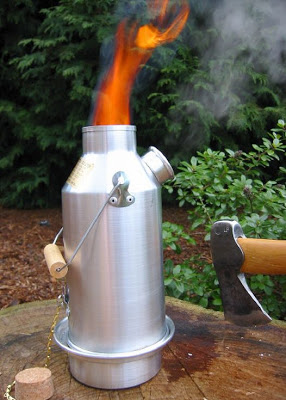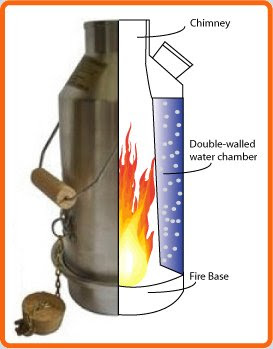 The Kelly Kettle on the boil.
The Kelly Kettle on the boil.My thanks to Stan for drawing my attention to the existence of the Kelly Kettle. He writes:
Top o' the morning, good Sir;
Congratulations on stirring the nest of vipers with the latest chapter. I sincerely hope the literary critics will be content to admire (or not, as the case may be) from afar.
I thought I'd mention this bit of kit, which seems to be relatively
unknown in the US:
https://kellykettle.com/
in case you find it interesting or appropriate for the task at hand to slip into some praxis post.
I use a variation on the theme called Thermette, from New Zealand, which is a slightly modernized rendition of the old "benghazi boiler" as used by NZ troops in WW2. It is an effective bit of camping gear, boiling quite a bit of water with but a handful of twigs/leaves/etc, and very quickly at that. But the real Thermette (copper, and not a Chinese made clone) is difficult to come by and it's heavy.
These Kelly kettles seem to have a fine reputation, and they ship to the US directly from Ireland at a good discount compared to the one or two US ("unauthorized"?) distributors. They even have a stainless kettle available.
Clearly this is not something to dangle off a MOLLE vest and take into battle, but it's a handy item for an extended stay in the bush or as a dirt-simple emergency preparedness item.
Cheers,
-S
III
 How the Kelly Kettle works.
How the Kelly Kettle works.From an English campimg website product review:
The Kelly Kettle is a uniquely designed kettle originating from the west coast of Ireland. Here they have been used for over a hundred years by the ghillies (angling guides) at Lough Conn to quickly boil water using twigs, dried leaves and other bits of wood found around the lake shore as fuel for the kettle.
The kettle comprises a double-skinned wall that holds water and a central open chimney. It sits on a small aluminium base with one large aperture as an air inlet within the base, which greatly increases the draw of the fire. Because the water is held within the kettle wall it means that a large surface area of water is exposed to the heat and therefore boils very quickly.
Visiting anglers to Lough Conn were so impressed by this kettle they spread the word and now Kelly kettles have grown in popularity around the world, being used by a wide range of people. We find they are an indispensable part of equipment to have in a woodland, where there is an endless supply of fuel.
How to use a Kelly kettle:
- Remove the kettle from the base and fill with water.
- Put some tinder into the base of the kettle and light. We tend to carry a firesteel, which is a very good way of lighting a fire without matches or a lighter.
- When the tinder is lit, put the kettle back onto the base (ensuring the cork is not in) and quickly feed the fire with twigs, dry leaves, or whatever other materials you have at hand, by dropping them through the chimney. When we are in a woodland we find that the side branches of conifer trees work very well in the Kelly kettle as they are brittle and full of resin so catch light quickly, even in wet weather.
- The water should boil quickly (usually 3-5 minutes) and then you can have yourself a nice cup of tea!
Ryan Jordan at BackpackingLight.com posts this review:
http://www.backpackinglight.com/cgi-bin/backpackinglight/reviews/display_reviews.html?forum_thread_id=1011
Rating: 4 / 5
The recent review of the Stratus Trailstove motivated me to post a review of a similar (in concept) wood burning device, the Kelly Kettle.
I've had the 1 pint Kelly Kettle for a few years. I purchased it from Wildernessaccess.com.
The first modification I did was replace the absurdly heavy cotton bag with a SpinSack. Second, I replaced the link chain that connects the cork spoutcap to the kettle with a piece of very thin photo hanging wire.
The Kelly Kettle is not "lightweight" by our standards, and it's bulky (nature of its design: water vessel is integrated). I primarily use it for watercraft (drift boat, pontoon boat) float-camping trips, and seldom take it hiking (too bulky), although I do take it camping in the spring/fall when the focus is on basecamping). The 1 pt version does not have enough water capacity for anything but solo use.
At 13 oz, it's light enough to take on long trips in wet, cold conditions where I want to make a lot of hot brews.
Having used the Zip Stove and a variety of hobo cans, I've found the Kelly Kettle to be the best performing wood burner so far. The volcano effect really does work, and chimney throughput is outstanding. Having the chimney go up through the center of the water vessel is sheer design brilliance for maximizing heat exchange, and the Kelly Kettle does regularly give me a pint of boiled water within 4 minutes of striking the match.
I take small bits of Esbit as firestarters, which means I can pretty much use any fuel I find: twigs, leaves, cones, needles, grass. A few handfuls of reasonably dry crud off the forest floor is about all I need, with the edge given to dead pine needles. Fuel that burns FAST and hot is what you want: twigs are actually the least useful form of fuel because they burn slow.
The Kelly Kettle is very well made, has a wonderful history about it, and just plain works.
If they can lighten it up (titanium?) to 8 oz so it's measurably lighter than the Titanium Zip Stove, I'd give it a '5', as there is not much else I would do to improve it. -- Ryan Jordan
Finally, there is an excellent review of the product in a controlled test here:
http://www.oldjimbo.com/survival/kellystove.html
Here's the irony for me: I never knew these suckers existed, even though I saw one a few months back in a thrift store here in Birmingham. Being ignorant, I passed it up for a mere $6.99! I had no idea at the time what it was and, funds as usual being short, I set it back down on the shelf. It no doubt was eagerly snatched up by somebody who knew what they were looking at. Oi veh! I just now tripped trying to kick myself in the butt.
Thanks, Stan for the Praxis suggestion.
Mike
III
13 comments:
This would be a handy implement to load onto your bicycle or into your canoe for a scouting foray.
The handful of pine needles needed to heat water for coffee or instant soup offers a low thermal signature and the availability of nearly instant hot water is indispensable to the man-on-the-move.
Also, having a Kelly Kettle, a water purifier and a half-dozen packets of dehydrated food would be an undoubted advantage should the need ever arise for a quick bug out.
MALTHUS
Yeah, big, heavy, produces a LOT of smoke....and priceyel
I'll keep my MSR dragonfly multifuel for liquid fuels (mogas, white gas, diesel, jet fuel, kerosene, cleaning fluid, etc) or my canteen cup stove if I really need to burn wood.
Something else to keep an eye out for. I've never even HEARD of these things, but as someone who enjoys mechanical engineering, I love the simplicity and efficiency of the design. Brilliant!
Mike, thank you for continuing to educate and passing along all the good bits to the rest of us.
B Woodman
III-per
After looking at the Kelly Kettle home site, I think I'll eventually end up getting several of these: one largest for basecamping & EmComm use, one smallest for backpacking, plus several spare bases. Plus a few for gifts?
Q: Aluminum for weight & quick heat transfer vs Stainless steel for durability. . . .
Q: I wonder how well these would work on an infantry mogas stove? Or would I even want to?
Q: All the spare parts I saw were of Aluminum. Do they make a spare stainless steel base for the largest Kettle? I didn't see one.
B Woodman
III-per
AFAIK, Kelly Kettle don't make a steel base. But one can surely be improvised if need be. My Thermette has a simple steel base with no bottom -- seems like a "tin" can of the appropriate diameter with holes cut out should be an equivalent replacement.
I'm not suggesting that a storm kettle should replace an MSR, and in fact they'll have to pry my almost 20 year old MSR multifuel out of my hot dead fingers.
For water discipline though, the kettle is faster and more enjoyable to use. And you can warm or cook something up top as the water readies. And the fuel is inexhaustible. It's also a teaching tool I use with my little boy, getting him to help with starting and feeding the fire.
All in all, a storm kettle is a nice little trinket, a reminder of a bygone age before honor and principle were institutionally bred out of our population, and I enjoy it quite a bit.
-S
III
Had to laugh when I first read of this handy little kettle about a week ago. I've had one for several years, and it's the best water boiler there is. Use it in the field every time I go, to be sure it's not a backpacking item; but, at this time, almost an indispensible piece of field equipment. You have no idea how quickly you can have boiling hot water for any small use, the big one only provides a little over a quart, after all. Anyway, this little kettle is great. If you don't have one, make an effort to acquire.
I can't help thinking that a donut shaped kettle would work just as well. Take the concept, but design it to work anywhere, even a gas stove, and not just the designated base.
I have used a Fire-Spout 100 for some years
http://www.occuk.co.uk/outdoor
It does take a bit longer to boil than a KK but it's a much better cooking stove and it folds flat
the KK it a bit bulky
[A] storm kettle is a nice little trinket, a reminder of a bygone age before honor and principle were institutionally bred out of our population,..--Anon
That is well phrased. Thanks for posting it.
MALTHUS
This stove looks like a descendant of a Chinese hot pot (Korean sinsulo) in a more portable form.
Here's another interesting system:
http://www.titaniumgoat.com/TiTri.html
-S
My large stainless Kelly Kettle had a leaking seam that appeared after three boils. I e-mailed Patrick at Kelly Kettle and he sent me a new one that he guarantees will not leak.
That's customer service!
HD
This was a very nice and well thought out review. Not many know about this great product yet.
Post a Comment